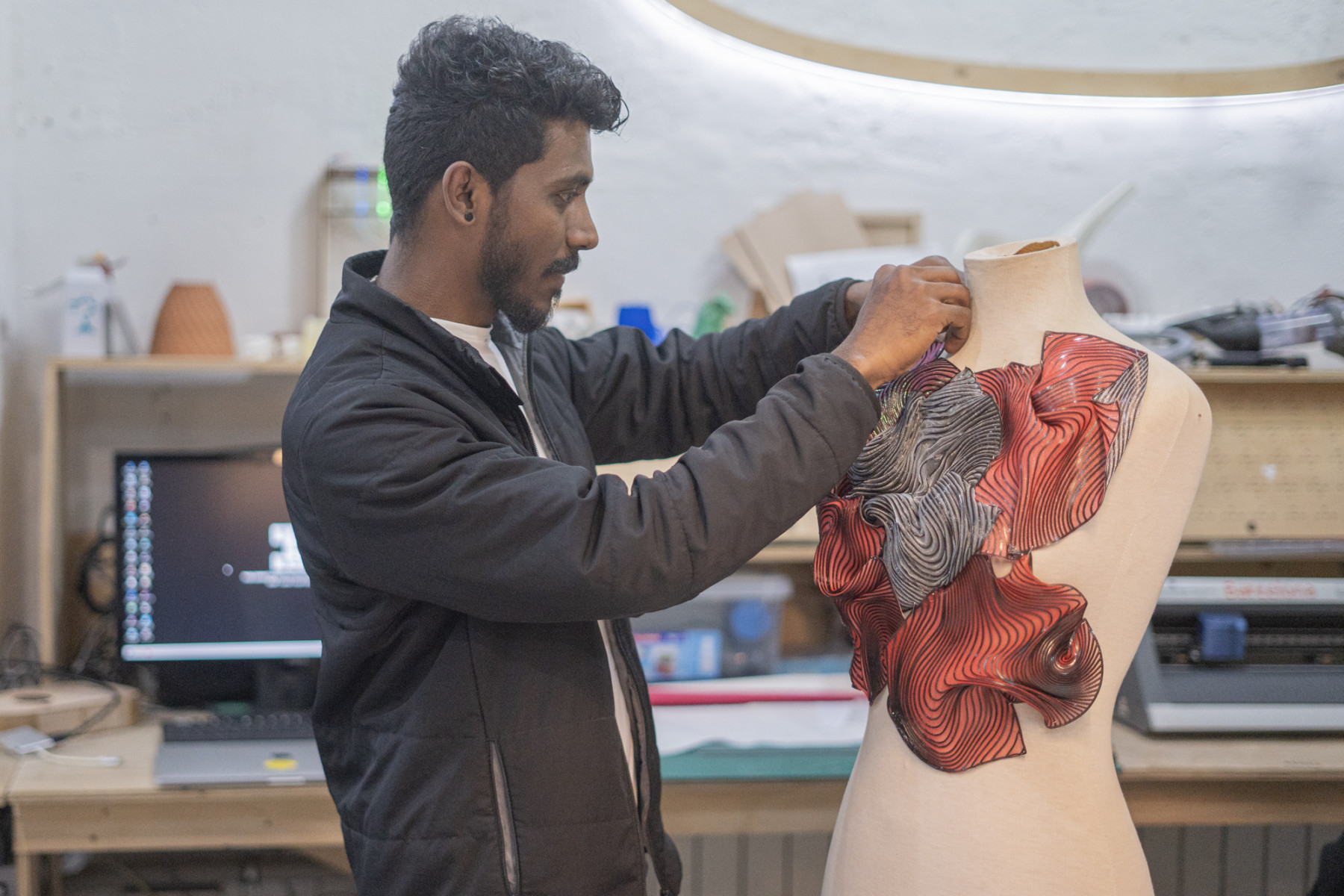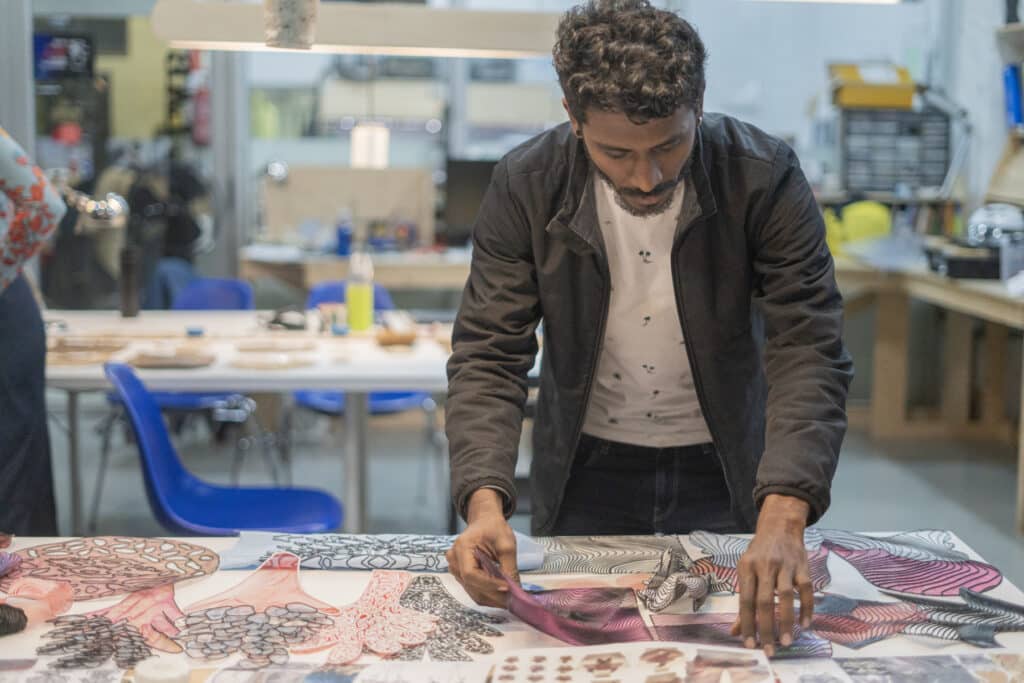
When wearable art and high fashion meet
The exploratory journey towards a more sustainable and innovative future by a Fabricademy student.
Meet Dineshkumar, a current Fabricademy student from Tirupur, India. In the following interview, he reveals when he knew that this program was the perfect match for him, how he’s navigating through it and what it takes to create a handcrafted fashion collection.
1. Tell us a bit about yourself. What did you study?
I come from Tirupur, Tamil Nadu, which is also known as the knitwear capital of India. My educational background includes a B. Tech in Fashion Technology from Sona College of Technology in Salem. I also studied a Postgraduate Diploma in Fashion Design from Pearl Academy in Jaipur.
2. What happened after?
During my post-graduation, I created a collection of wearable art pieces inspired by Dravidian temple architecture using advanced techniques such as 3D printing, laser cutting, machine embroidery, and pleating. However, I had to rely heavily on experts’ assistance to achieve this, and I realized that I lacked the skills to experiment on my own. After completing my education, I worked as a Visual Merchandiser for GAP in Chennai for a year before moving on to work for DreamTheatre in Mumbai. There, I started as a Designer and Brand Assurance Executive and quickly worked my way up to the position of Design Head and Associate Manager for popular brands such as Pokemon, Hellokitty, Smiley, Real Madrid, Liverpool, FIFA, and more. However, after gaining experience in graphic design for five years, I realized that I lacked the necessary skills to pursue my dream of creating handcrafted wearable art pieces using technology. That’s when I came across Fabricademy, and I knew it was the perfect fit for me.
3. When did you feel like it was time to apply?
I realized that my current job as a graphic designer wasn’t aligned with my passion for creating wearable art fashion collections. While the job provided me with comfort, it didn’t offer the resources or skills required to pursue my dreams. However, the COVID-19 pandemic and the resulting long break gave me a chance to reflect on my aspirations and take the necessary steps to pursue them.
During my research, I discovered Fabricademy. It perfectly aligns with my interests in working with various technologies and adopting sustainable work methods. The program has an experimental approach that focuses on both advanced technology and sustainability. Its unique curriculum and short & intensive nature would allow me to experiment and acquire skills in a brief period. This was exactly what I needed to learn the skills and knowledge necessary to follow my dream.
I was also motivated by the works of many alumni who had achieved great success in the field after completing the program. Their inspiring works encouraged me to pursue a career too.
“I realized that I lacked the necessary skills to pursue my dream of creating handcrafted wearable art pieces using technology. That’s when I came across Fabricademy.”
4. What tools, techniques and machines have you explored so far?
During Phase One of the program, I had the opportunity to have hands-on experience with tools such as laser cutting machines, 3D printers, CNC milling machines, machine embroidery, vacuum machines, heat setting machines, robotic arm scanners, bio labs tools, digital fabrication techniques and more. The assignments in this phase required me to use these machines repeatedly, which helped me develop confidence and become proficient in using them under supervision.
Moving on to Phase Two, I decided to focus on the intersection of technology and textiles, specifically by working with 3D printing. During the computational Couture week, we were taught how to use Rhino and Grasshopper software to design and fabricate computational designs. This knowledge is highly relevant nowadays, where parametric design is becoming increasingly popular across industries. As someone who is interested in the fashion industry, I draw inspiration from the works of designers such as Iris Van Herpen, Julia Koerner, Travis Fitch, Filippo Nassetti, and many others who are known for their futuristic designs.
As part of my project, I have been exploring the possibilities of 3D printing on different types of textiles, such as organza, mesh, and polyester. Through experimentation, I am identifying how the textiles react when connected by printing using filaments like PLA or TPU materials. I am also experimenting with various designs, material thicknesses, malleable techniques, double sandwich techniques, and more to create unique and innovative designs.
5. When did you realize you had an idea you could develop here?
For years, I had been fascinated with the idea of creating wearable art and high fashion designs but it wasn’t until I enrolled in Fabricademy that I had the opportunity to revisit my past works and rediscover my passion with time to experiment.
During the initial concept stage, we had a global session to discuss our ideas and review inspiring projects from previous years. This session opened up endless possibilities and allowed us to gain insights into various approaches to the design process. We had weekly mentoring sessions with experts who helped us refine our ideas and pushed us to explore new boundaries in our research. These mentoring sessions were invaluable in helping me gain a deeper understanding of the design process and develop a solid work process that allowed me to proceed further. In addition to working closely with our mentors, we were also encouraged to connect with different experts to get a more diverse range of perspectives.
Once we had a clear idea of what we wanted to achieve, we were eager to begin exploring possible materials. The experimentation process was both intense and exciting as we tried out new and different materials to achieve surprising results. There were times when we stumbled upon happy accidents that left us speechless and provided us with new avenues to explore.
Overall, the process of developing my idea was challenging, but it was an extremely fulfilling experience. The combination of inspiration, guidance, and experimentation helped me to develop a deeper understanding of the design process and allowed me to create unique and innovative designs that I had only dreamed of before.
“There were times when we stumbled upon happy accidents that left us speechless and provided us with new avenues to explore.”
6. Did your peers help you in prototyping your idea?
Yes! During our breaks, we engaged in discussions about our project ideas, which proved to be extremely valuable. Our conversations were enriched by each person’s unique background and expertise.
Overall, I found that collaborating was a great way to receive feedback and insights that I may not have considered otherwise. It was a truly collaborative environment that encouraged creativity and exploration, and I am grateful for the opportunity to have worked with such talented and diverse individuals.
7. Do you feel that you’re now part of a network?
That’s a definite yes! Moreover, Fabricademy’s global network of nodes offers me the chance to learn from diverse perspectives and expand my knowledge beyond my immediate surroundings. I am excited about the prospect of sharing my experiences with other students from around the world.
8. Who would you recommend Fabricademy to?
I would recommend this course to anyone who is interested in exploring fabrication, wearable technology, bio-fabrication, sustainability, and other related topics. In my personal experience, I have shared some of my course projects on social media, and I have noticed that friends with backgrounds in textiles and fashion have shown particular interest in the course.
9. If you were a material, which one would you be and why?
I think I would like to be a malleable material because I really value being flexible and adaptable in my life. When a material is malleable, it means it can be easily shaped or molded into different forms without breaking or cracking. This is similar to how I would like to be in my own life. I want to be able to adapt to different situations and environments without losing my core identity or values.
Another reason to choose this material is because it implies a willingness to change and grow. Just like a malleable material can be transformed into something different, I want to be open to learning and evolving over time. This is an important quality to have if I want to be resilient, versatile, and receptive to new challenges.
“I am excited about the possibilities that arise when combining the precision and versatility of 3D printing with the creativity and vision of fashion design.”
10. Imagine you have already graduated. What comes next?
I am particularly interested in pursuing a career in additive manufacturing technology in fashion. I believe that 3D printing and techniques can revolutionize the fashion industry by enabling designers to create customized, and visually striking products.
With the skills and knowledge gained through Fabricademy, I am excited about the possibilities that arise when combining the precision and versatility of 3D printing with the creativity and vision of fashion design.
Ultimately, my goal is to contribute to the ongoing evolution of the fashion industry towards a more sustainable and innovative future. I believe that by continuing to develop my skills and knowledge in additive manufacturing, I can make a meaningful contribution to this exciting and rapidly evolving field.
Curious to learn more?
Read everything there is to know about Fabricademy!





